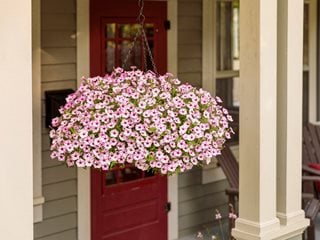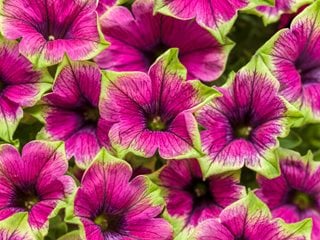How to Grow Stunning Supertunias
Love petunias? Try Supertunias to get all the qualities you adore about petunias, plus much more! Published 7/20/2022
Supertunia Mini Vista® Pink Star shows off its pink-on-white star pattern. The trailing nature of Supertunias make them a great plant for hanging baskets. Photo by: Proven Winners.
Supertunias are, quite literally, a super petunia. And we’re here to tell you that they do indeed live up to their namesake. Here, you’ll learn five reasons to grow Supertunias in your garden, get answers to some frequently asked questions, and see some of the most popular varieties.
FIVE REASONS TO GROW SUPERTUNIAS
1. They don't need deadheading.
Petunia lovers know that to get those cherished blooms to continue all summer, you must stay on top of deadheading. But, removing spent flowers can be a chore.
Luckily, Supertunias are self-cleaning, which means they don't require this step. This makes them ideal for gardeners who are crunched for time or need to be away from their plants for stretches of time over summer.
While you don't have to, you definitely can deadhead Supertunias if you don’t like to see the expired flowers on the plant. It won’t hurt them if you do.
2. They produce more flowers.
For most flowering annuals, their entire mission is to bloom and then set seed. However, Supertunias are bred to be sterile and do not produce viable seed. This makes them more vigorous than typical petunias, allowing them to put more energy into flowering than producing seed.
3. They are resistant to plant diseases & viruses.
All Proven Winners plants are guaranteed to be bred from disease-free and virus-indexed tissue cultures, which greatly enhances their performance in the garden.
4. They add long-lasting color to the garden.
Just how long do Supertunias last? Whether in your container or garden bed, you’ll get a show from early spring into fall—until your first frost. During that entire time, they’ll bloom profusely.
5. They are easy to care for.
Supertunias provide a surprising bounty of flowers for how little effort is required to maintain them.
See this video that shows how to successfully care for your Supertunias..

One of many Supertunias with eye-catching color that delights, Supertunia® Picasso in Purple® provides vibrant pink and lime green color to the garden. Photo by: Proven Winners.
TIPS FOR GROWING STUNNING SUPERTUNIAS
Here are the basics to keep in mind when caring for your Supertunia plants.
- Water. Supertunias love water, so keep them evenly moist so they won’t dry out or wilt. If you have them in containers or hanging baskets, they tend to dry out faster than when planted in the ground.
- Fertilizer. Petunias in general are hungry flowers, and the same goes for Supertunias. If you notice that your Supertunia is still growing well but isn’t producing as many blooms, that probably means it needs some fertilizer. Similar to watering, keep in mind that Supertunias in containers will be hungrier than Supertunias planted in the ground. Proven Winners recommends feeding every 3rd watering; or, if you're in a hot climate and water every day, then feed once a week.
- Sun. Supertunias should be planted in a location that gets at least 6 hours of full sun. An adequate amount of sunlight will encourage more blooms.
- Prune. Like many other plants, Supertunias benefit from being cut back. If your Supertunia starts looking scraggly or leggy, cutting it back will give it the boost it needs to grow back fuller.
See this short video with tips for trimming back your Supertunia plants..

The double lavender flowers with deep purple veins make Supertunia® Priscilla a plant worthy of going solo in a container. Photo by: Proven Winners.
FREQUENTLY ASKED QUESTIONS
Do Supertunias come back every year?
In most areas of the country, Supertunias are treated as an annual. However, if you are in Zones 10 or 11, growing them as perennials is a possibility. If you’re not in one of those zones, you can attempt to grow it as a perennial by keeping it a container and moving the container to a protected area before your first frost.
What are the Supertunia types?
Within the Supertunias, there are several groups: Supertunia (classic/regular), Supertunia Vista, Supertunia Mini Vista. Each type has varying mounding habits, trailing habits, flower sizes, and more.
Wave® petunias versus Supertunias: What's the difference?
Even though they are often confused, Supertunias and Wave petunias (or Tidal Wave petunias) are not one in the same. Wave petunias are grown from seed (and therefore produce seed and fewer flowers) and are not self-cleaning.
POPULAR SUPERTUNIAS
SUPERTUNIA VISTA® BUBBLEGUM®
Buy Now or Find a Local RetailerWith it’s medium-sized bright pink flowers, Supertunia Vista® Bubblegum® brightens any garden setting. All Supertunia Vista® petunias are vigorous growers. When planted in the landscape, they can mound up to 2 feet high. In baskets and containers, they trail up to 4 feet.
SUPERTUNIA® HONEY™
Buy Now or Find a Local RetailerEye-catching blooms of Supertunia® Honey™ range in color, offering hues of yellow, orange salmon, and pinks from spring through fall. It can mound to a foot high and spreads to 2 feet when planted in the landscape. In a container, it can spread up to about 3 feet.
SUPERTUNIA® BLACK CHERRY®
Buy Now or Find a Local RetailerDeep red Supertunia® Black Cherry® is one of the most popular in the Supertunia series, much-loved for its vibrant color. In the landscape, it can mound up to 1 foot tall and spread to about 2 feet wide. Plays the role of “spiller” in the hanging baskets and containers.
SUPERTUNIA® ROYAL VELVET®
Buy Now or Find a Local RetailerThe deep purple blooms of Supertunia® Royal Velvet® are sure to create an eye-catching scene whether planted in a container or in a garden bed. It’ll look good with just about any other color, but it’s especially charming with yellows and pinks. Mounds up to 1 foot high and spreads to about 2 feet.
SUPERTUNIA® BORDEAUX™
Buy Now or Find a Local RetailerIts lilac flower and deep purple center makes floriferous Supertunia® Bordeaux™ a knockout in garden beds or containers. It mounds up to 1 foot and spreads to 2 feet. It makes a great spiller for containers, trailing up to 3 feet.
FIVE WAYS TO USE SUPERTUNIAS IN YOUR GARDEN
Supertunias are versatile plants that come in a variety of colors, making them a great addition to any garden. Here are some ways to use them in yours.

1. PUT THEM IN A CONTAINER COMBINATION.
Because of their trailing habits, Supertunias make a great spiller when combined with other plants in a container. When choosing what to pair them with, make sure to choose plants with similar growing conditions. Get hundreds of container ideas here.
Pictured: Paired with an upward-growing vine, Supertunia Vista® Snowdrift™ trails at the base of the containers that flank this backyard walkway.

2. MAKE THEM A FOCAL POINT.
While Supertunias look fabulous when combined with other plants, they are perfect all on their own. For a simple yet gorgeous display, let your Supertunia shine alone in a beautiful container.
Pictured: This geometric container gives a floriferous purple Supertunia® Bordeaux™ a spot to show off its plummy-pink flowers with deep, rich plum-purple veins.

3. LET THEM SPREAD.
Use the spreading habits of Supertunias to your benefit by allowing them to be the main attraction in a garden bed.
Pictured: Here, Lemon Coral sedum provides a stunning contrast to spreading Supertunia Vista® Fuchsia. Requiring little care, the spreading Supertunia also helps make this garden bed low maintenance by keeping weeds suppressed.

4. USE THEM AS CENTERPIECES.
Even though they’re known for being trailing plants, Supertunias can also serve as a tidy centerpiece when trimmed back regularly.
Pictured: Paired with Diamond Frost® euphorbia, Supertunia® Blue Skies makes an adorable centerpiece.

5. USE THEM AS BORDER PLANTS.
Due to their spreading nature and easy maintenance, Supertunias make great borders for garden beds.
Pictured: The pink of Supertunia Vista® Bubblegum® and vibrant Supertunia Vista® Fuchsia create a visual border for this garden bed full of stunners.














